Hands on with the ASUS Fonepad, and ASUS PadFone Infinity
by Brian Klug on February 25, 2013 7:08 PM EST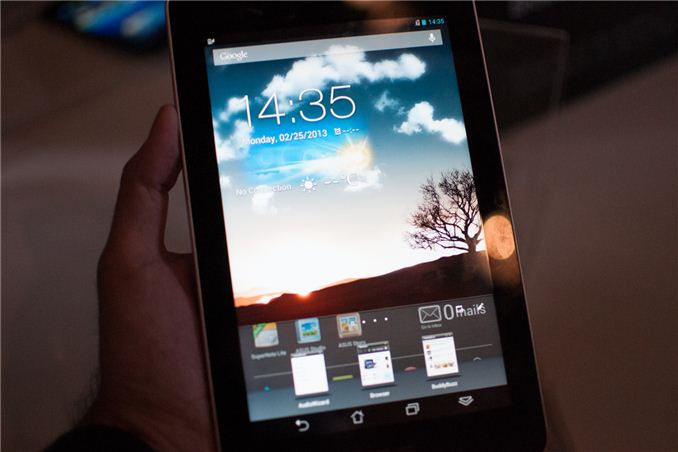
In its annual tradition at MWC, ASUS held a press conference off-site to introduce some of its mobile devices. The introductions are always interesting and typically unique in the marketplace. This year was no different.
To kick things off, ASUS introduced the Fonepad: a 7-inch Android 4.1.2 tablet that also serves as a phone. Samsung launched the Galaxy Note 8.0 earlier this week with a similar capability. While I don't expect many folks to want to hold a 7-inch tablet up to their face, having the ability to combine both tablet and smartphone functionality into one can be tempting. I can see the Fonepad being compelling if you don't make calls all that often but would rather carry a small tablet than a large smartphone, or if you are fine using a Bluetooth headset.
The device is pretty much a Nexus 7 but with a nice metal back. The dimensions are near identical to the Nexus 7 at 196.4mm x 120.1mm x 10.4mm with a weight of 340 grams. The display resolution remains 1280 x 800 and the IPS panel is LED backlit.
In a curious change of pace, ASUS integrated Intel's Atom Z2420 SoC (single-core + HT, 1.2GHz 32nm, PowerVR SGX 540). I'm curious to see how the single core, low-clocked Atom SoC does compared to Tegra 3 in a tablet. Driving all phone functionality is Intel's XMM 6265 baseband, with support for 850/900/1900/2100MHz WCDMA and 850/900/1800/1900MHz EDGE/GSM bands. There's support for 802.11b/g/n and BT 3.0.
The Fonepad features 1GB of LPDDR2 memory and 16GB of NAND on-board, with a microSD slot for additional storage expansion (a notable absence from the Nexus 7). There's an integrated 16Wh battery (like in the N7) and the device will be available in titanium gray and champagne gold (like the Transformer Prime).
The big selling point of the Fonepad is its price: $249. That's a pretty impressive deal for a full featured smartphone and 7-inch tablet in one. It's a bit of a quirky product, but I can definitely see the Fonepad filling a niche.
Next up is the ASUS PadFone Infinity. For those of you who aren't familiar with the PadFone concept, it's pretty simple. Take a phone that can dock into and power a tablet display and you have PadFone. The tablet part is strictly a display + battery, all compute and connectivity is driven by the phone element.
The PadFone Infinity takes a 5-inch 1080p Snapdragon 600 based smartphone running Android 4.2 and pairs it with a 10.1-inch 1920 x 1200 tablet dock (the PadFone Infinity Station). The phone weighs 141g and features an integrated 2400mAh battery, while the tablet dock weighs 530g and comes with a 5000mAh battery.
The phone integrates 2GB of LPDDR2-1066, and will come in both 32GB and 64GB versions. ASUS claims support for 802.11b/g/n and 802.11ac with WiFi Direct, BT 4.0 and NFC. Thanks to Qualcomm's baseband, there's full DC-HSPA+ and UE category 3 LTE support.
The PadFone features a 13MP rear facing camera with f/2.0 aperture lens and a 2MP front facing camera. When in tablet mode, the rear camera remains unimpeded while the front camera is replaced with a 1MP module.
Video out is supported via a Mobility DisplayPort interface (MyDP) that runs over the standard micro-USB port on the PadFone.


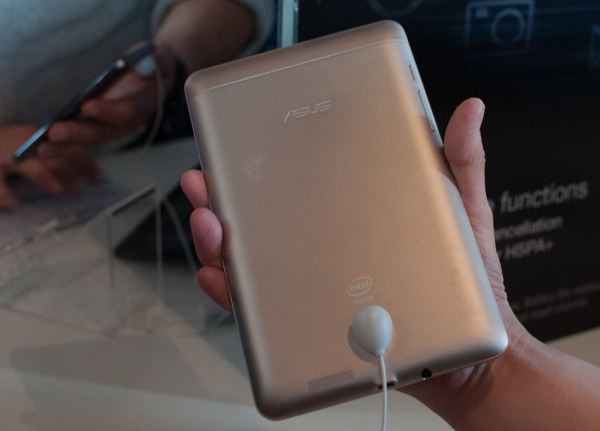

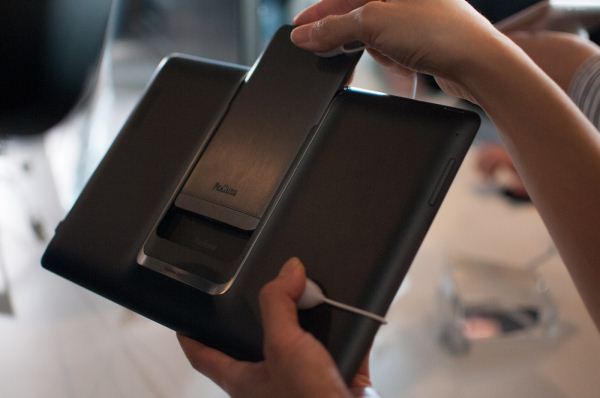
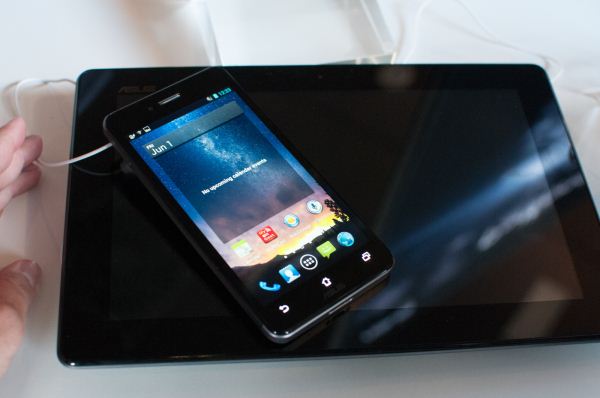
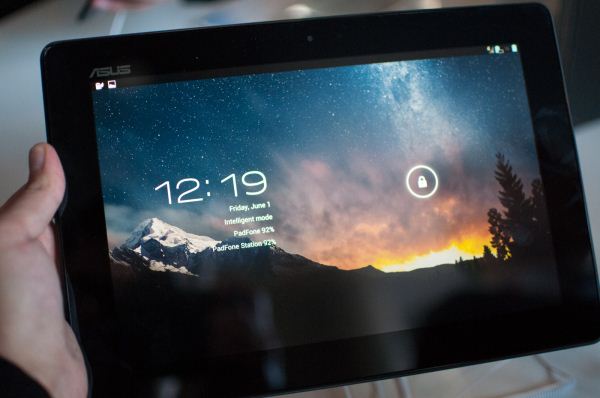














69 Comments
View All Comments
Wilco1 - Thursday, February 28, 2013 - link
It's not just prefetching, Tegra 3 for example suffers due to its single channel memory. Exynos 4 beats it in pretty much every benchmark. Memory controllers are an area where Intel has more expertise, but hopefully NVidia has learnt how to get it right with Tegra 4(i).Note you can already find some benchmarks between the Samsung Chromebook and Ivy-Bridge based Chromebooks.
I'm not sure how you can see cross platform benchmarking as being unfair. Yes there is always a small OS component in each benchmark - even SPEC makes OS calls. It does affect the scores somewhat, but not by a huge percentage. Besides being hard to avoid in general, it's actually a realistic reprentation of the OS overhead. If a particular OS has a higher overhead, then any software will run slower on it, including benchmarks.
Note this is quite different from how JavaScript benchmarks differ even on the same device. If you have doubts about cross platform benchmarking then you understand the issue with JavaScript benchmarking!
evonitzer - Wednesday, February 27, 2013 - link
The Tegra 4 and 4i aren't even out yet! I don't really know much about Geekbench. Does it correlate well with actual performance, or is it purely theoretical? The tests on Anandtech show the Atom in positive light, to this day (except the GPU).Maybe you're right. Maybe it is severely outclassed by top of the line processors, but stick to ones that are at least in devices today. And let's wait for this implementation in this tablet (and the tests when it is released). The
And then, let's remember at the last that this thing is CHEAP!
smartypnt4 - Wednesday, February 27, 2013 - link
Geekbench, when compared on devices with the same OS, gives isolated measures of performance similar to theoretical maximums of throughput. As such, the Atom is on par with an A9, technically speaking, unless you're talking FP performance.The thing is, the memory interface is really that much better. Sunspider has been characterized by AnandTech as being more of a cache test than anything else, so that's why the Atom does so well: it's way faster than most things in the memory access department.
In this tablet, it should do fine.
Wilco1 - Thursday, February 28, 2013 - link
Geekbench is not the best benchmark around, but it is much better than SunSpider. SunSpider is worse than Dhrystone, it consists of several tiny functions of about 10 lines of code. As such it is easy to add optimizations which give a huge speedup on SunSpider but don't improve general JS performance.And because it is JavaScript, what you actually benchmark is not the CPU but the JIT compiler in a particular browser. Different browsers (even versions) show major differences in JS performance. That is particularly true on ARM, where JIT compilers are still improving with each new version (on x86 good JITs are available).
The problem is that Anand appears to report non-optimal JS results, if you Google for it you can usually find much faster results than what he reports - because others use a different browser or download the latest version. So either he should report the fastest result or just stop showing JS benchmarks at all as they are too browser dependent.
evonitzer - Thursday, February 28, 2013 - link
Yes, I've noticed this when comparing my phone to Anand's (or Brian's) results. I'm using CM10, so my results tend to be a lot different. But the same is true on Geekbench, or just about any benchmark, which shows significant variability with different software builds on the same phone.But it's not quite fair to say that you don't test the CPU with JS benchmarks, because how else to explain the differences. It just doesn't correlate as well as the tests suggest. Comparison- My cappy scores about ~2400 ms. Way better than the fascinate he used in the test, but also nowhere near the top of the lists, and I doubt any optimizations will make it faster than the iPhone 5, RAZR i, or Nexus 10.
Do you think all browser benchmarks should be thrown out? Anandtech prefers them because they are better cross platform, but the are always browser dependent to some extent. The RAZR-i does pretty well in browser based benchmarks too (for whatever that is worth).
Wilco1 - Thursday, February 28, 2013 - link
No the same is not true for real CPU benchmarks. These are by definition native code, so you only rely on the compiler used. Typically you standardize to the same GCC version across platforms. If you run Geekbench on multiple Android devices then you actually run the exact same binary, so the only differences are due to CPU performance.Contrast that with JavaScript benchmarks where each device may use different browsers and JIT compilers. Even on the same hardware you can get wildly different results with various browsers. That means JS benchmarks are not CPU benchmarks. A faster CPU should give a better score of course, but only if you use the exact same browser and OS. That means it is very hard to compare JS results cross platform.
For example the Cortex-A15 SunSpider scores reported by Anand are 1384 for Nexus 10 and 690 for the Samsung Chromebook. They both use Exynos 5250 at 1.7GHz and the same browser (Chrome). Even Anand seemed surprised there. Some Googling reveals much faster Nexus 10 scores however:
Dolphin Beta: 693.2ms
AOSP: 794.6ms
Ocean: 835.7ms
Boat: 837.3ms
Firefox: 972.2ms
Firefox Beta: 993.4ms
Dolphin: 1132.7ms
Chrome: 1354.0ms
So there you have it, a factor 2 difference. And Anand only reports the slowest score of them all. The same is true for most other Android phones and tablets - I call that misleading, and I expect better from him.
I'd certainly say get rid of SunSpider as it is worse than Dhrystone. If you must have JS benchmarks use the newer larger ones like Octane and Kraken - just don't expect actual browsing performance to relate to the scores.
To conclude JavaScript benchmarks are NOT CPU benchmarks. My 2.7GHz i5-2500S reports 868ms for SunSpider with IE9 on Win7, does that mean a Nexus 10 will outperform my PC? Or even browse faster?
wsw1982 - Friday, March 1, 2013 - link
The different score is basically because the operational system and the CPU throttle.Running the chrome browser on a ATOM netbook with windows xp is much faster than on the same netbook with windows vista. Although they are both chrome, and both on a netbook, the operational system are different.
The Nexus 10 is a tablet, and the Chrome book is a notebook. The E5250 is throttled to different watts, the 1.7ghz is just the maximum frequency it can reach. That's like the the i7 ulv and normal i7, they both have the same tubo speed (2.7ghz), but different throttle/base frequency (1.7ghz vs. 2.3ghz) for different TDP (17w vs 35w)
Do you really think a benchmark can show the different between windows vista and windows xp or the difference between i7 ulv and i7 normal is worse than the one cannot?
Wilco1 - Friday, March 1, 2013 - link
No the Nexus 10 is definitely not being throttled. Did you even read my post? How could another browser achieve the same 690ms score as the Chromebook if it was being throttled???And no the OS has little to do with it either. It's the browser and the WebKit version which most browsers use (this does the actual JIT compilation). Just like different devices come with different Android versions, they come with different browser versions as well.
I don't understand your question. My point is that an updated Chrome on the Nexus 10 will be able to achieve the same 690ms score as Chromebook. If you disagree, please explain how other browsers (which use the same WebKit) could possibly achieve the 690 score on Nexus 10.
Kidster3001 - Thursday, March 14, 2013 - link
Sunspider is FAR more dependent on the javascript engine being used than the CPU or anything else. Check any of the newer phones, pull libwebcore.so and see what version of libv8.so is being used. The newer version of v8 wins sunspider almost everytime. If it doesn't then there are further software customizations put in place by the manufacturer to overcome the libv8 deltas. Sunspider has absolutely nothing to do with CPU performance unless both devices are using the same v8 engine. I have seen Sunspider score vary by over 800 msecs on the same phone just by using a different version of the Android browser with an older v8 engine.This is one of the reasons why Mobile Chrome for Android was not good until R25. It had an older version of v8 than the stock Android browser.
wsw1982 - Friday, March 1, 2013 - link
Each CPU has it's strong and weakness, especially when you compare CPU from two different architecture. With selective benchmark, you can of course declare whatever you want. How interesting is it?Base on Vellamo benchmark, I could also declare the Z2420 is faster than 1.4GHz Exynos 4 in Galaxy S3.
http://www.fonearena.com/blog/61522/xolo-x500-benc...
Almost on all benchmarks, the z2420 beats the dual-core ARM a9, which is the ARMy chip target the same market segment. And in some benchmark it faster than Quad core A9 or krait.